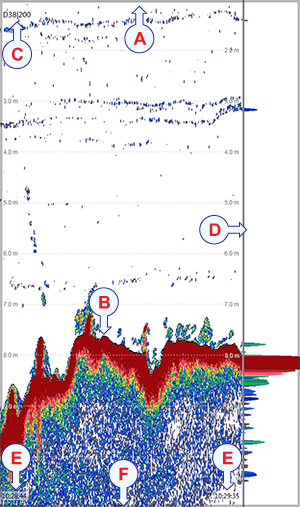Surface echogram description
A Surface echogram is mainly used when you wish to look at the entire water column starting from the sea surface and down to the sea
bottom. Since this echogram is referenced to the sea surface, the sea bottom contour will vary with the actual depth. You can select the start range (the depth from which the echogram starts) and the vertical range (the vertical "length" of
the echogram) by means of the Start Range and Range settings. Both the Range and the Start Range functions are located on the Main menu.
How to open

To activate Surface echogram, click in the chosen view to make it "active". Select Echogram on the Active menu. Select the Echogram tab to open the page. On the Echogram page, set Echogram type to Surface.
Description
The Surface echogram is often used to study the water column from a few meters under the hull and down to the bottom. If you set up the Start Range and Range depths to place the sea bottom contour at the lower end of the echogram, you will have good opportunity to study the echoes
from the water column. Since this echogram is referenced to the sea surface, the sea bottom contour will vary with the actual depth.
The biomass is automatically calculated based on choices you make in the Calculation Interval dialog box; within a given time frame, a defined number of pings, or a portion of the echogram view. The data is then taken from an echo area starting immediately after the transmit pulse, and ending just over the detected
depth.
If you have limited your vertical range (using the Start Range and Range settings), the resulting area is used for the biomass calculation. If the seabed is clearly defined with a unique bottom detection, the bottom echo will not be included in the calculations. Therefore, if you switch the bottom detector off, the bottom echo will be included in the calculation.
Tip


For closer investigation, use the Zoom information pane to enlarge echoes from the water column or the bottom.

| A | This is the start depth of the echogram In a Surface echogram you may wish to start the echogram from the surface, and will then set the Start Range to 0 (zero). You will then see the transmit pulse as a strong echo at the top of the echogram. Try setting Start Range to a small value, for example 1 meter. The echogram will then start immediately under the keel or transducer face.
|
| B | This is the bottom (seabed) The bottom is shown with a strong contour. Since the echogram is referenced to the sea surface, the bottom will vary with
the actual depth. Different bottom conditions will have a visual effect on how the bottom echo is drawn. A hard bottom (rock) will give you
a stronger echo - and thus a darker colour - than a soft bottom (mud or silt).
The Echogram page in the Echogram dialog box allows you to make adjustments to the bottom contour. You can add a black bottom line, and a white line to make the bottom "stand out".
|
| C | Transducer identification This text identifies the transducer - and thus also the channel - used to create the echogram. In this context, the term channel is used as a common term to identify the combination of transceiver, transducer and operating frequency.
|
| D | This is the scope view The Scope view is used to indicate how strong each echo is. The colour and the length of each line reflects the received echo amplitude.
|
| E | These are the labels Small labels are shown in the bottom left and right corners of the view. These labels can contain time or distance to identify the horizontal axis of the echogram. You can hide the labels from view.
The labels can be changed on the Horizontal Axis page in the Echogram dialog box.
|
| F | This is the lower end of the chosen depth range This depth is normally a few meters below the bottom contour, depending on the chosen range. The total echogram range (A) to (F) is defined with the Range button on the Main menu.
|
Example
Start Range in a surface related echogram
In a surface echogram, set the Start Range value to 10 meters. This will make the echogram start from 10 meters below the sea surface (provided that the transducer
offset has been defined). Set Range to the current depth plus 20 meters. The echogram will now show the area from 10 meters below the sea surface, and down to
10 meters “below” the bottom. The bottom contour is easily detected when the depth changes.